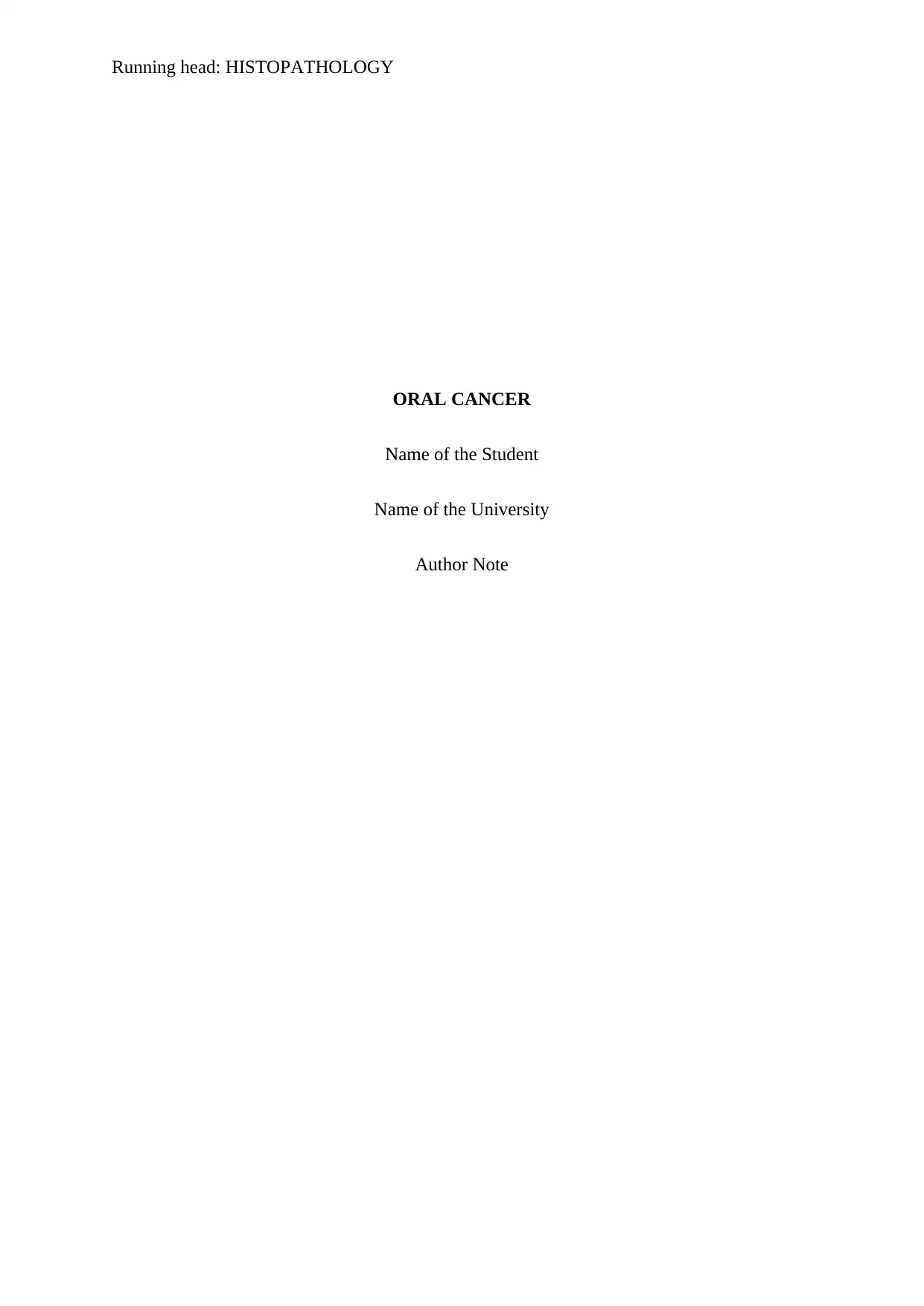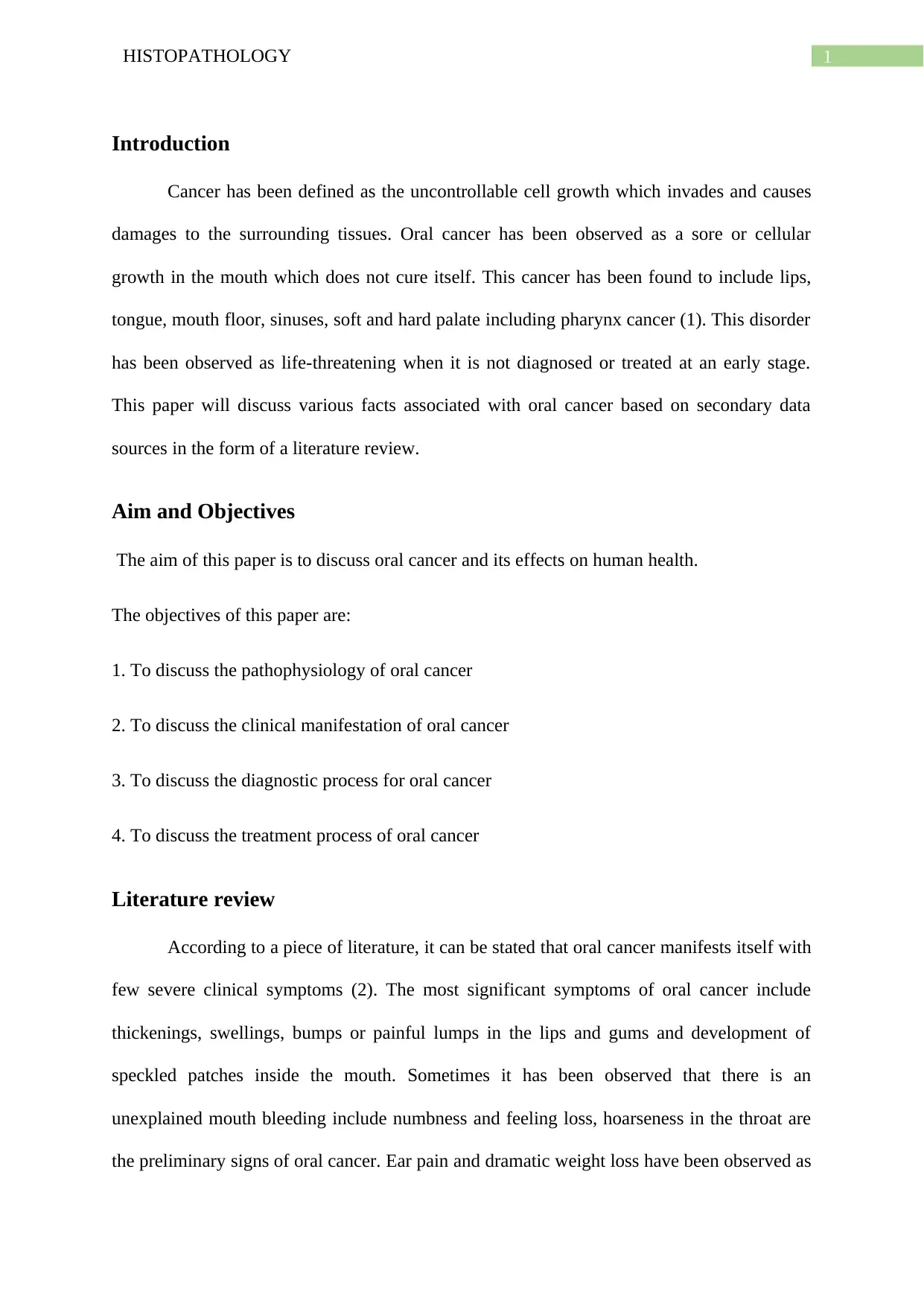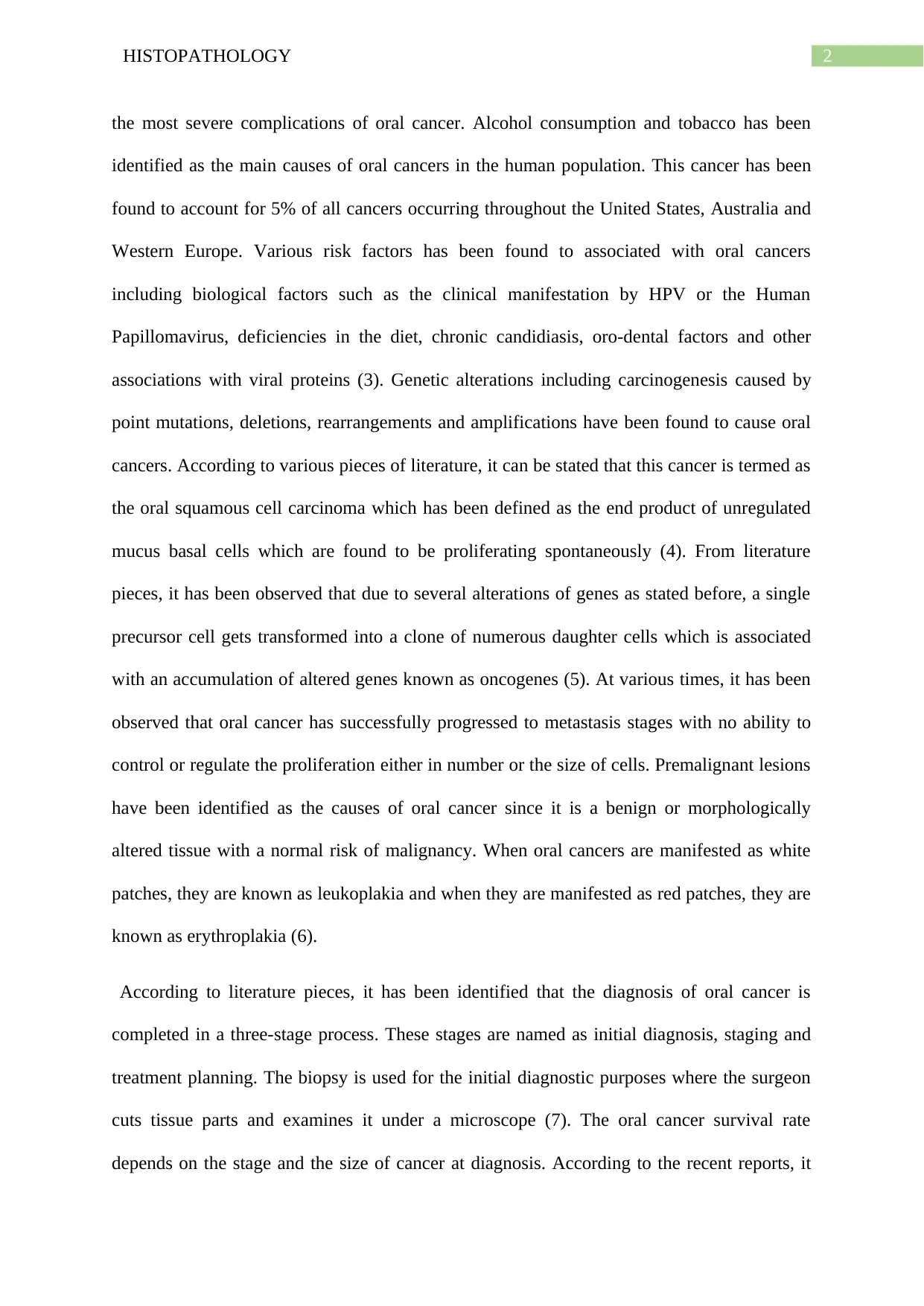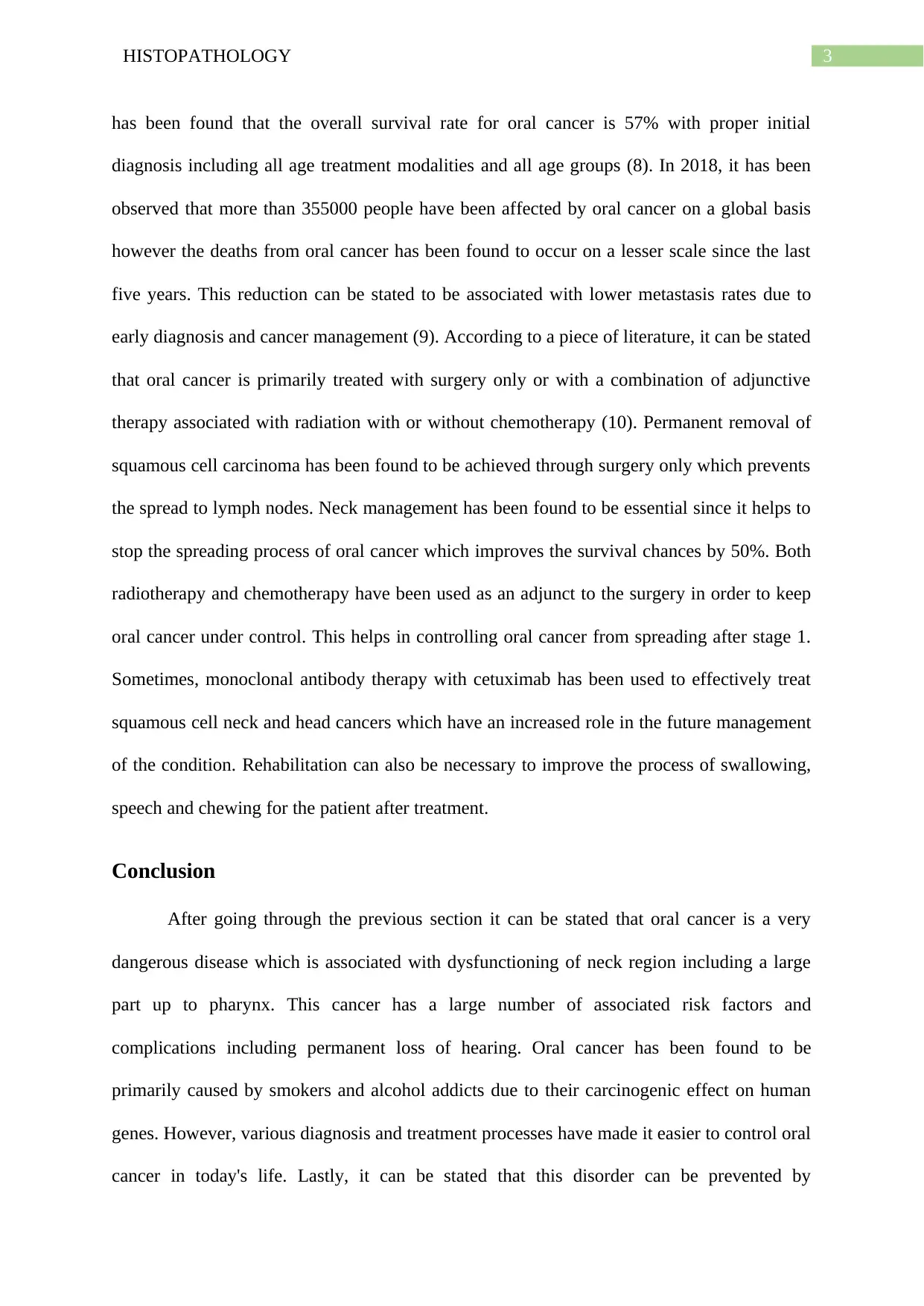Oral Cancer: Pathophysiology, Manifestation, Diagnosis, and Treatment
VerifiedAdded on 2022/08/28
|6
|1154
|23
Report
AI Summary
This report provides a comprehensive literature review on oral cancer, discussing its pathophysiology, clinical manifestations, diagnostic processes, and various treatment options. It highlights key symptoms such as thickenings, swellings, and unexplained bleeding, while also identifying alcohol and tobacco use as primary risk factors. The report delves into the biological aspects, including HPV and genetic alterations leading to oral squamous cell carcinoma. It outlines the three-stage diagnostic process involving biopsy, and discusses the survival rates associated with early diagnosis. Treatment modalities, including surgery, radiation, and chemotherapy, are explored, along with the potential use of monoclonal antibody therapy and rehabilitation for improved patient outcomes. The report concludes by emphasizing the importance of a healthy lifestyle and early detection in preventing and managing this dangerous disease.

Running head: HISTOPATHOLOGY
ORAL CANCER
Name of the Student
Name of the University
Author Note
ORAL CANCER
Name of the Student
Name of the University
Author Note
Paraphrase This Document
Need a fresh take? Get an instant paraphrase of this document with our AI Paraphraser

1HISTOPATHOLOGY
Introduction
Cancer has been defined as the uncontrollable cell growth which invades and causes
damages to the surrounding tissues. Oral cancer has been observed as a sore or cellular
growth in the mouth which does not cure itself. This cancer has been found to include lips,
tongue, mouth floor, sinuses, soft and hard palate including pharynx cancer (1). This disorder
has been observed as life-threatening when it is not diagnosed or treated at an early stage.
This paper will discuss various facts associated with oral cancer based on secondary data
sources in the form of a literature review.
Aim and Objectives
The aim of this paper is to discuss oral cancer and its effects on human health.
The objectives of this paper are:
1. To discuss the pathophysiology of oral cancer
2. To discuss the clinical manifestation of oral cancer
3. To discuss the diagnostic process for oral cancer
4. To discuss the treatment process of oral cancer
Literature review
According to a piece of literature, it can be stated that oral cancer manifests itself with
few severe clinical symptoms (2). The most significant symptoms of oral cancer include
thickenings, swellings, bumps or painful lumps in the lips and gums and development of
speckled patches inside the mouth. Sometimes it has been observed that there is an
unexplained mouth bleeding include numbness and feeling loss, hoarseness in the throat are
the preliminary signs of oral cancer. Ear pain and dramatic weight loss have been observed as
Introduction
Cancer has been defined as the uncontrollable cell growth which invades and causes
damages to the surrounding tissues. Oral cancer has been observed as a sore or cellular
growth in the mouth which does not cure itself. This cancer has been found to include lips,
tongue, mouth floor, sinuses, soft and hard palate including pharynx cancer (1). This disorder
has been observed as life-threatening when it is not diagnosed or treated at an early stage.
This paper will discuss various facts associated with oral cancer based on secondary data
sources in the form of a literature review.
Aim and Objectives
The aim of this paper is to discuss oral cancer and its effects on human health.
The objectives of this paper are:
1. To discuss the pathophysiology of oral cancer
2. To discuss the clinical manifestation of oral cancer
3. To discuss the diagnostic process for oral cancer
4. To discuss the treatment process of oral cancer
Literature review
According to a piece of literature, it can be stated that oral cancer manifests itself with
few severe clinical symptoms (2). The most significant symptoms of oral cancer include
thickenings, swellings, bumps or painful lumps in the lips and gums and development of
speckled patches inside the mouth. Sometimes it has been observed that there is an
unexplained mouth bleeding include numbness and feeling loss, hoarseness in the throat are
the preliminary signs of oral cancer. Ear pain and dramatic weight loss have been observed as

2HISTOPATHOLOGY
the most severe complications of oral cancer. Alcohol consumption and tobacco has been
identified as the main causes of oral cancers in the human population. This cancer has been
found to account for 5% of all cancers occurring throughout the United States, Australia and
Western Europe. Various risk factors has been found to associated with oral cancers
including biological factors such as the clinical manifestation by HPV or the Human
Papillomavirus, deficiencies in the diet, chronic candidiasis, oro-dental factors and other
associations with viral proteins (3). Genetic alterations including carcinogenesis caused by
point mutations, deletions, rearrangements and amplifications have been found to cause oral
cancers. According to various pieces of literature, it can be stated that this cancer is termed as
the oral squamous cell carcinoma which has been defined as the end product of unregulated
mucus basal cells which are found to be proliferating spontaneously (4). From literature
pieces, it has been observed that due to several alterations of genes as stated before, a single
precursor cell gets transformed into a clone of numerous daughter cells which is associated
with an accumulation of altered genes known as oncogenes (5). At various times, it has been
observed that oral cancer has successfully progressed to metastasis stages with no ability to
control or regulate the proliferation either in number or the size of cells. Premalignant lesions
have been identified as the causes of oral cancer since it is a benign or morphologically
altered tissue with a normal risk of malignancy. When oral cancers are manifested as white
patches, they are known as leukoplakia and when they are manifested as red patches, they are
known as erythroplakia (6).
According to literature pieces, it has been identified that the diagnosis of oral cancer is
completed in a three-stage process. These stages are named as initial diagnosis, staging and
treatment planning. The biopsy is used for the initial diagnostic purposes where the surgeon
cuts tissue parts and examines it under a microscope (7). The oral cancer survival rate
depends on the stage and the size of cancer at diagnosis. According to the recent reports, it
the most severe complications of oral cancer. Alcohol consumption and tobacco has been
identified as the main causes of oral cancers in the human population. This cancer has been
found to account for 5% of all cancers occurring throughout the United States, Australia and
Western Europe. Various risk factors has been found to associated with oral cancers
including biological factors such as the clinical manifestation by HPV or the Human
Papillomavirus, deficiencies in the diet, chronic candidiasis, oro-dental factors and other
associations with viral proteins (3). Genetic alterations including carcinogenesis caused by
point mutations, deletions, rearrangements and amplifications have been found to cause oral
cancers. According to various pieces of literature, it can be stated that this cancer is termed as
the oral squamous cell carcinoma which has been defined as the end product of unregulated
mucus basal cells which are found to be proliferating spontaneously (4). From literature
pieces, it has been observed that due to several alterations of genes as stated before, a single
precursor cell gets transformed into a clone of numerous daughter cells which is associated
with an accumulation of altered genes known as oncogenes (5). At various times, it has been
observed that oral cancer has successfully progressed to metastasis stages with no ability to
control or regulate the proliferation either in number or the size of cells. Premalignant lesions
have been identified as the causes of oral cancer since it is a benign or morphologically
altered tissue with a normal risk of malignancy. When oral cancers are manifested as white
patches, they are known as leukoplakia and when they are manifested as red patches, they are
known as erythroplakia (6).
According to literature pieces, it has been identified that the diagnosis of oral cancer is
completed in a three-stage process. These stages are named as initial diagnosis, staging and
treatment planning. The biopsy is used for the initial diagnostic purposes where the surgeon
cuts tissue parts and examines it under a microscope (7). The oral cancer survival rate
depends on the stage and the size of cancer at diagnosis. According to the recent reports, it
⊘ This is a preview!⊘
Do you want full access?
Subscribe today to unlock all pages.

Trusted by 1+ million students worldwide

3HISTOPATHOLOGY
has been found that the overall survival rate for oral cancer is 57% with proper initial
diagnosis including all age treatment modalities and all age groups (8). In 2018, it has been
observed that more than 355000 people have been affected by oral cancer on a global basis
however the deaths from oral cancer has been found to occur on a lesser scale since the last
five years. This reduction can be stated to be associated with lower metastasis rates due to
early diagnosis and cancer management (9). According to a piece of literature, it can be stated
that oral cancer is primarily treated with surgery only or with a combination of adjunctive
therapy associated with radiation with or without chemotherapy (10). Permanent removal of
squamous cell carcinoma has been found to be achieved through surgery only which prevents
the spread to lymph nodes. Neck management has been found to be essential since it helps to
stop the spreading process of oral cancer which improves the survival chances by 50%. Both
radiotherapy and chemotherapy have been used as an adjunct to the surgery in order to keep
oral cancer under control. This helps in controlling oral cancer from spreading after stage 1.
Sometimes, monoclonal antibody therapy with cetuximab has been used to effectively treat
squamous cell neck and head cancers which have an increased role in the future management
of the condition. Rehabilitation can also be necessary to improve the process of swallowing,
speech and chewing for the patient after treatment.
Conclusion
After going through the previous section it can be stated that oral cancer is a very
dangerous disease which is associated with dysfunctioning of neck region including a large
part up to pharynx. This cancer has a large number of associated risk factors and
complications including permanent loss of hearing. Oral cancer has been found to be
primarily caused by smokers and alcohol addicts due to their carcinogenic effect on human
genes. However, various diagnosis and treatment processes have made it easier to control oral
cancer in today's life. Lastly, it can be stated that this disorder can be prevented by
has been found that the overall survival rate for oral cancer is 57% with proper initial
diagnosis including all age treatment modalities and all age groups (8). In 2018, it has been
observed that more than 355000 people have been affected by oral cancer on a global basis
however the deaths from oral cancer has been found to occur on a lesser scale since the last
five years. This reduction can be stated to be associated with lower metastasis rates due to
early diagnosis and cancer management (9). According to a piece of literature, it can be stated
that oral cancer is primarily treated with surgery only or with a combination of adjunctive
therapy associated with radiation with or without chemotherapy (10). Permanent removal of
squamous cell carcinoma has been found to be achieved through surgery only which prevents
the spread to lymph nodes. Neck management has been found to be essential since it helps to
stop the spreading process of oral cancer which improves the survival chances by 50%. Both
radiotherapy and chemotherapy have been used as an adjunct to the surgery in order to keep
oral cancer under control. This helps in controlling oral cancer from spreading after stage 1.
Sometimes, monoclonal antibody therapy with cetuximab has been used to effectively treat
squamous cell neck and head cancers which have an increased role in the future management
of the condition. Rehabilitation can also be necessary to improve the process of swallowing,
speech and chewing for the patient after treatment.
Conclusion
After going through the previous section it can be stated that oral cancer is a very
dangerous disease which is associated with dysfunctioning of neck region including a large
part up to pharynx. This cancer has a large number of associated risk factors and
complications including permanent loss of hearing. Oral cancer has been found to be
primarily caused by smokers and alcohol addicts due to their carcinogenic effect on human
genes. However, various diagnosis and treatment processes have made it easier to control oral
cancer in today's life. Lastly, it can be stated that this disorder can be prevented by
Paraphrase This Document
Need a fresh take? Get an instant paraphrase of this document with our AI Paraphraser

4HISTOPATHOLOGY
maintaining a healthy lifestyle if he or she does not have a genetic connection with the
disease.
maintaining a healthy lifestyle if he or she does not have a genetic connection with the
disease.

5HISTOPATHOLOGY
References
1.http://www.cancerjournal.net/article.asp?
issn=09731482;year=2016;volume=12;issue=2;spage=458;epage=463;aulast=Kumar
2. https://www.ncbi.nlm.nih.gov/pmc/articles/PMC5506386/
3. https://europepmc.org/article/med/29072384
4. https://www.bjoms.com/article/S0266-4356(17)30576-4/abstract
5. https://onlinelibrary.wiley.com/doi/abs/10.1111/jop.12863
6. https://www.mdpi.com/1422-0067/19/6/1704
7.http://www.journaldmims.com/article.asp?
issn=09743901;year=2017;volume=12;issue=2;spage=148;epage=153;aulast=Sune
8. https://www.sciencedirect.com/science/article/abs/pii/S0305737217300695
9. https://www.sciencedirect.com/science/article/abs/pii/S0901502718300286
10. https://www.ncbi.nlm.nih.gov/pmc/articles/PMC6555318/
References
1.http://www.cancerjournal.net/article.asp?
issn=09731482;year=2016;volume=12;issue=2;spage=458;epage=463;aulast=Kumar
2. https://www.ncbi.nlm.nih.gov/pmc/articles/PMC5506386/
3. https://europepmc.org/article/med/29072384
4. https://www.bjoms.com/article/S0266-4356(17)30576-4/abstract
5. https://onlinelibrary.wiley.com/doi/abs/10.1111/jop.12863
6. https://www.mdpi.com/1422-0067/19/6/1704
7.http://www.journaldmims.com/article.asp?
issn=09743901;year=2017;volume=12;issue=2;spage=148;epage=153;aulast=Sune
8. https://www.sciencedirect.com/science/article/abs/pii/S0305737217300695
9. https://www.sciencedirect.com/science/article/abs/pii/S0901502718300286
10. https://www.ncbi.nlm.nih.gov/pmc/articles/PMC6555318/
⊘ This is a preview!⊘
Do you want full access?
Subscribe today to unlock all pages.

Trusted by 1+ million students worldwide
1 out of 6
Related Documents
Your All-in-One AI-Powered Toolkit for Academic Success.
+13062052269
info@desklib.com
Available 24*7 on WhatsApp / Email
![[object Object]](/_next/static/media/star-bottom.7253800d.svg)
Unlock your academic potential
Copyright © 2020–2025 A2Z Services. All Rights Reserved. Developed and managed by ZUCOL.





